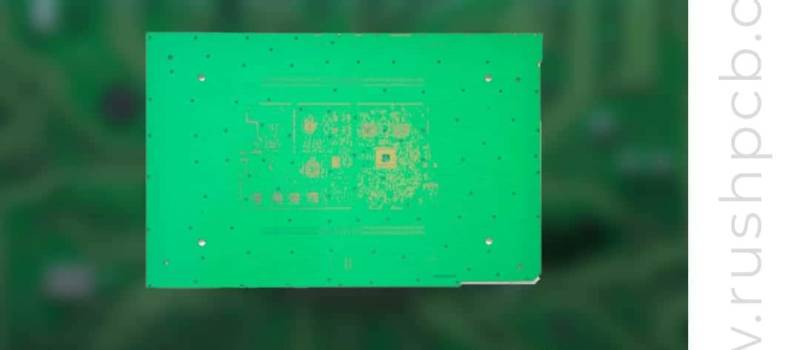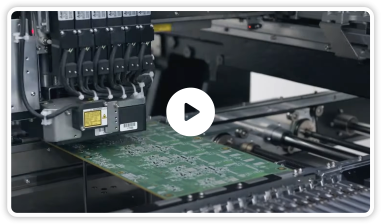| Type | Standard | Advanced |
|---|---|---|
| Single-ended % | ± 10 | ± 5 |
| Differential, Edge-coupled % | ± 10 | ± 5 |
| Differential, Broadside-Coupled % | ± 10 | ± 10 |
Transitioning a board to manufacturing can be a tense moment, especially if the board is a new design. To ensure the manufacturer can reproduce your design reliably, Rush PCB Inc. recommends you communicate a complete set of requirements. Among the important points that you must clearly specify to the manufacturer are the targets for impedance control. Not only does this help prevent any confusion, but also helps the design review process.

Why is Impedance Control Important?
Impedance control in PCBs is essential to ensure signal integrity—reliable signal transmission and reception. This becomes important, especially in high-speed circuits like those in networking devices or computer motherboards.
It is important to understand impedance and to manage it effectively to maintain signal integrity, and to prevent issues like signal distortion and EMI or electromagnetic interference.
What is Impedance Control?
Impedance in PCBs is a measure of the opposition to current passing in the circuit. Resistances, capacitance, and inductances present in the circuit contribute to impedance.
Controlling the impedance in PCBs refers to the regulation of the electrical impedance of the signal traces in the circuit board. In high-speed circuits, for instance, impedance control means maintaining the proper impedance all along the traces carrying the high-speed signal. This is essential to ensure reliable signal transmission and reception.
Failure to maintain proper impedance means a change or mismatch in the impedance at some point or points in the trace. This can result in signal distortion, generation of EMI, and reflections. All of which will degrade the circuit performance.
Steps to Achieve Effective Impedance Control
Typically, a high-speed digital circuit will have specific traces or conducting paths on the board that carry high-speed signals between different components. The designer must follow certain steps to achieve effective impedance control on these paths, such as:
- Identify Critical Signals — Determine the signals and paths on which to exercise impedance control. Typically, these will be clock signals and/or high-speed data lines.
- Determine the Required Impedance — Calculate the required impedance for each path based on the signal speed, standards, and specifications.
- Design the Trace Geometry — Decide the width, spacing, and thickness of traces to meet the impedance requirements.
- Select Suitable Dielectric Material — In consultation with the PCB manufacturer, choose the proper insulating material with the right permittivity.
- Design the Layer Stack-Up — Properly arrange the stacking of copper and dielectric layers that will achieve the desired impedance.
- Inform the Manufacturer — Provide the manufacturer with unambiguous information to allow them to use controlled techniques during fabrication to match the specified impedance.
- Test and Validate — Use TDR or Time-Domain Reflectometry to accurately measure and verify impedance.
What Are the Major Controlled Impedances in PCBs?
Proper signal propagation and circuit performance depend significantly on the impedance of the path through which the signal travels. Different pathways have their individual characteristics that affect their impedance. To help in understanding these characteristics, engineers have defined some major types of impedance as follows:
- Microstrip — This is the most commonly used controlled impedance type in PCBs. It involves placing a signal trace on one side of a dielectric layer, with a ground plane on the other. This type of controlled impedance is easy to design and is cost-effective.
- Stripline — Another commonly used controlled impedance in PCBs. Here, the signal trace remains sandwiched between two ground planes. Although more expensive to design and manufacture compared to microstrip, it offers better shielding and is better suited for high-frequency signals.
- Dual Stripline — Similar to the stripline design but involving two signal traces in place of a single trace. The presence of two ground planes on either side offers better isolation and shielding. Dual stripline is suitable for the transmission of differential signals.
- Edge-Coupled Microstrip — This type of controlled impedance involves two signal traces placed parallel to one another on a dielectric layer. Edge-coupled microstrip offers good isolation between high-speed signals.
- Edge-Coupled Stripline — Similar to the edge-coupled microstrip, but with two ground planes placed on either side of the two signal traces. The presence of ground planes offers better shielding. This is suitable for high-frequency signals.
Apart from the above, the impedance of a trace also depends on whether the trace is:
- Single-Ended — Designers typically use single-ended traces for routing clock signals or connections to DAC/ADC interfaces. Most single-ended traces use a controlled impedance value of 50 or 75 ohms to match the impedance of most drivers, thereby preventing signal reflections. To hit the target impedance, designers tailor the trace width and spacing to the ground.
- Differential — Designers typically use a pair of traces to carry complementary signals, thereby increasing noise immunity. The two traces typically run close together, creating a coupling effect. The effect is to reject common mode noise. The most common value of controlled impedance for differential pairs is around 100 ohms.
- Terminated or Non-Terminated — These require different management for proper impedance control. While terminated lines typically use discrete resistors at the end to prevent reflections, non-terminated traces require tuning the impedance along the entire track.
Effect of Geometry on Controlled Impedance
The geometry of traces significantly affects the controlled impedance. For instance, both stripline- and microstrip-type controlled impedance use reference planes. While a microstrip has only one reference plane, a stripline is fully enclosed between two reference planes.
Changing the trace dimensions, the dielectric material between the traces and planes, and the dielectric thickness allows for managing the controlled impedance. While wider traces and thinner dielectrics will typically lower the impedance, narrow traces, and thicker dielectrics will raise it. Surface roughness and glass weave type also impact the impedance.
Stripline allows the tightest control of impedance, as the trace is completely enclosed between reference planes. On the other hand, microstrips are easier to fabricate but will have a wider tolerance.
Choosing the Right Controlled Impedance
The designer must consider several factors when choosing the right controlled impedance for a specific PCB design. These include the signal frequency, size of the board, and the cost.
While microstrip is the most common type of controlled impedance suitable for most applications, stripline is suitable for high-frequency signals and has better shielding but is more expensive and difficult to fabricate.
If your application has differential signals, you may use dual-stripline, but it will take up more board space. For high-speed applications, you may consider using edge-coupled stripline or edge-coupled microstrip controlled impedance, as they provide better isolation between signals and better shielding.
How Manufacturers Handle Controlled Impedance?
PCB manufacturers play a critical role in maintaining the controlled impedance during fabrication. Numerous steps in the manufacturing process can affect the impedance of the trace. These include etching, plating, and laminating. We ensure the trace impedance remains within the specified tolerances by using specialized equipment and processes.
Contact Us
At Rush PCB Inc., we understand the importance of controlled impedance for a successful PCB design, especially for high-speed applications. We are a reliable PCB manufacturer with decades of experience and expertise in producing high-quality PCBs. We offer precisely controlled impedance for your boards whether you need a small prototype batch or a large volume production run, on time and within your budget.
At Rush PCB Inc., we use the latest equipment and technology to ensure that every PCB we make meets the required impedance specifications. Our team of skilled technicians and engineers works closely with our customers to better understand their specific requirements and needs, thereby providing them with personalized solutions to ensure success.
Contact us today to start your next project on controlled impedance PCBs. Our team is available to provide you with a comprehensive quote along with excellent service. We will help you turn your ideas into reality.









